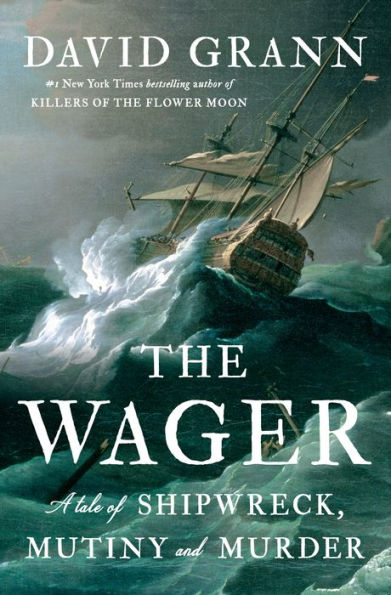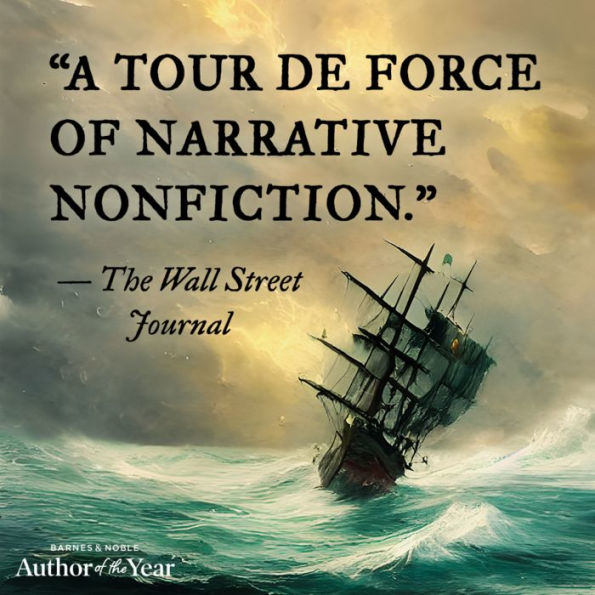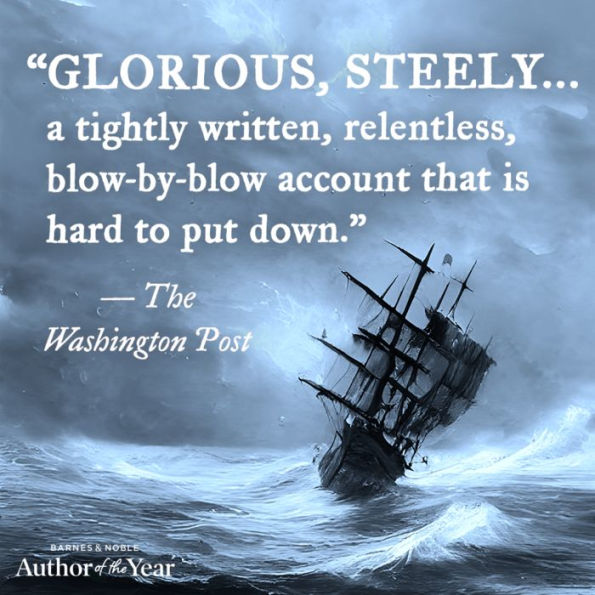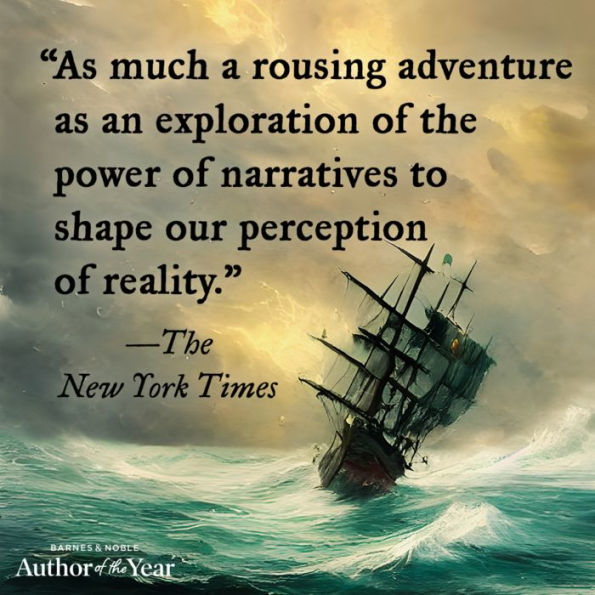Read an Excerpt
Chapter 1
The First Lieutenant
Each man in the squadron carried, along with a sea chest, his own burdensome story. Perhaps it was of a scorned love, or a secret prison conviction, or a pregnant wife left on shore weeping. Perhaps it was a hunger for fame and fortune, or a dread of death. David Cheap, the first lieutenant of the Centurion, the squadron’s flagship, was no different. A burly Scotsman in his early forties with a protracted nose and intense eyes, he was in flight—from squabbles with his brother over their inheritance, from creditors chasing him, from debts that made it impossible for him to find a suitable bride. Onshore, Cheap seemed doomed, unable to navigate past life’s unexpected shoals. Yet as he perched on the quarterdeck of a British man-of-war, cruising the vast oceans with a cocked hat and spyglass, he brimmed with confidence—even, some would say, a touch of haughtiness. The wooden world of a ship—a world bound by the Navy’s rigid regulations and the laws of the sea and, most of all, by the hardened fellowship of men—had provided him a refuge. Suddenly he felt a crystalline order, a clarity of purpose. And Cheap’s newest posting, despite the innumerable risks that it carried, from plagues and drowning to enemy cannon fire, offered what he longed for: a chance to finally claim a wealthy prize and rise to captain his own ship, becoming a lord of the sea.
The problem was that he could not get away from the damned land. He was trapped—cursed, really—at the dockyard in Portsmouth, along the English Channel, struggling with feverish futility to get the Centurion fitted out and ready to sail. Its massive wooden hull, 144 feet long and 40 feet wide, was moored at a slip. Carpenters, caulkers, riggers, and joiners combed over its decks like rats (which were also plentiful). A cacophony of hammers and saws. The cobblestone streets past the shipyard were congested with rattling wheelbarrows and horse-drawn wagons, with porters, peddlers, pickpockets, sailors, and prostitutes. Periodically, a boatswain blew a chilling whistle, and crewmen stumbled from ale shops, parting from old or new sweethearts, hurrying to their departing ships in order to avoid their officers’ lashes.
It was January 1740, and the British Empire was racing to mobilize for war against its imperial rival Spain. And in a move that had suddenly raised Cheap’s prospects, the captain under whom he served on the Centurion, George Anson, had been plucked by the Admiralty to be a commodore and lead the squadron of five warships against the Spanish. The promotion was unexpected. As the son of an obscure country squire, Anson did not wield the level of patronage, the grease—or “interest,” as it was more politely called—that propelled many officers up the pole, along with their men. Anson, then forty-two, had joined the Navy at the age of fourteen, and served for nearly three decades without leading a major military campaign or snaring a lucrative prize.
Tall, with a long face and a high forehead, he had a remoteness about him. His blue eyes were inscrutable, and outside the company of a few trusted friends he rarely opened his mouth. One statesman, after meeting with him, noted, “Anson, as usual, said little.” Anson corresponded even more sparingly, as if he doubted the ability of words to convey what he saw or felt. “He loved reading little, and writing, or dictating his own letters less, and that seeming negligence . . . drew upon him the ill will of many,” a relative wrote. A diplomat later quipped that Anson was so unknowing about the world that he’d been “round it, but never in it.”
Nevertheless, the Admiralty had recognized in Anson what Cheap had also seen in him in the two years since he’d joined the Centurion’s crew: a formidable seaman. Anson had a mastery of the wooden world and, equally important, a mastery of himself—he remained cool and steady under duress. His relative noted, “He had high notions of sincerity and honor and practiced them without deviation.” In addition to Cheap, he had attracted a coterie of talented junior officers and protégés, all vying for his favor. One later informed Anson that he was more obliged to him than to his own father and would do anything to “act up to the good opinion you are pleased to have of me.” If Anson succeeded in his new role as commodore of the squadron, he would be in a position to anoint any captain he wanted. And Cheap, who’d initially served as Anson’s second lieutenant, was now his right-hand man.
Like Anson, Cheap had spent much of his life at sea, a bruising existence he’d at first hoped to escape. As Samuel Johnson once observed, “No man will be a sailor who has contrivance enough to get himself into a jail; for being in a ship is being in a jail, with the chance of being drowned.” Cheap’s father had possessed a large estate in Fife, Scotland, and one of those titles—the second Laird of Rossie—that evoked nobility even if it did not quite confer it. His motto, emblazoned on the family’s crest, was Ditat virtus: “Virtue enriches.” He had seven children with his first wife, and, after she died, he had six more with his second, among them David.
In 1705, the year that David celebrated his eighth birthday, his father stepped out to fetch some goat’s milk and dropped dead. As was custom, it was the oldest male heir—David’s half brother James—who inherited the bulk of the estate. And so David was buffeted by forces beyond his control, in a world divided between first sons and younger sons, between haves and have-nots. Compounding his upheaval, James, now ensconced as the third Laird of Rossie, frequently neglected to pay the allowance that had been bequeathed to his half brothers and half sister: some blood was apparently thicker than others’. Driven to find work, David apprenticed to a merchant, but his debts mounted. So in 1714, the year he turned seventeen, he ran off to sea, a decision that was evidently welcomed by his family—as his guardian wrote to his older brother, “The sooner he goes off it will be better for you and me.”
After these setbacks, Cheap seemed only more consumed by his festering dreams, more determined to bend what he called an “unhappy fate.” On his own, on an ocean distant from the world he knew, he might prove himself in elemental struggles—braving typhoons, outdueling enemy ships, rescuing his companions from calamities.
But though Cheap had chased a few pirates—including the one-handed Irishman Henry Johnson, who fired his gun by resting the barrel on his stump—these earlier voyages had proved largely uneventful. He’d been sent to patrol the West Indies, generally considered the worst assignment in the Navy because of the specter of disease. The Saffron Scourge. The Bloody Flux. The Breakbone Fever. The Blue Death.
But Cheap had endured. Wasn’t there something to be said for that? Moreover, he’d earned the trust of Anson and worked his way up to first lieutenant. No doubt it helped that they shared a disdain for reckless banter, or what Cheap deemed a “vaporing manner.” A Scottish minister who later became close to Cheap noted that Anson had employed him because he was “a man of sense and knowledge.” Cheap, the once-forlorn debtor, was but one rung from his coveted captaincy. And with the war with Spain having broken out, he was about to head into full-fledged battle for the first time.
The conflict was the result of the endless jockeying among the European powers to expand their empires. They each vied to conquer or control ever larger swaths of the earth, so that they could exploit and monopolize other nations’ valuable natural resources and trade markets. In the process, they subjugated and destroyed innumerable indigenous peoples, justifying their ruthless self-interest—including the reliance on the ever-expanding Atlantic slave trade—by claiming that they were somehow spreading “civilization” to the benighted realms of the earth. Spain had long been the dominant empire in Latin America, but Great Britain, which already possessed colonies along the American eastern seaboard, was now on the ascendance—and determined to break its rival’s hold.
Then, in 1738, Robert Jenkins, a British merchant captain, was summoned to appear in Parliament, where he reportedly claimed that a Spanish officer had stormed his brig in the Caribbean and, accusing him of smuggling sugar from Spain’s colonies, cut off his left ear. Jenkins reputedly displayed his severed appendage, pickled in a jar, and pledged “my cause to my country.” The incident further ignited the passions of Parliament and pamphleteers, leading people to cry for blood—an ear for an ear—and a good deal of booty as well. The conflict became known as the War of Jenkins’ Ear.
British authorities soon devised a plan to launch an attack on a hub of Spain’s colonial wealth: Cartagena. A South American city on the Caribbean, it was where much of the silver extracted from Peruvian mines was shipped in armed convoys to Spain. The British offensive—involving a massive fleet of 186 ships, led by Admiral Edward Vernon—would be the largest amphibious assault in history. But there was also another, much smaller operation: the one assigned to Commodore Anson.
With five warships and a scouting sloop, he and some two thousand men would sail across the Atlantic and round Cape Horn, “taking, sinking, burning, or otherwise destroying” enemy ships and weakening Spanish holdings from the Pacific coast of South America to the Philippines. The British government, in concocting its scheme, wanted to avoid the impression that it was merely sponsoring piracy. Yet the heart of the plan called for an act of outright thievery: to snatch a Spanish galleon loaded with virgin silver and hundreds of thousands of silver coins. Twice a year, Spain sent such a galleon—it was not always the same ship—from Mexico to the Philippines to purchase silks and spices and other Asian commodities, which, in turn, were sold in Europe and the Americas. These exchanges provided crucial links in Spain’s global trading empire.
Cheap and the others ordered to carry out the mission were rarely privy to the agendas of those in power, but they were lured by a tantalizing prospect: a share of the treasure. The Centurion’s twenty-two-year-old chaplain, Reverend Richard Walter, who later compiled an account of the voyage, described the galleon as “the most desirable prize that was to be met with in any part of the globe.”
If Anson and his men prevailed—“if it shall please God to bless our arms,” as the Admiralty put it—they would continue circling the earth before returning home. The Admiralty had given Anson a code and a cipher to use for his written communication, and an official warned that the mission must be carried out in the “most secret, expeditious manner.” Otherwise, Anson’s squadron might be intercepted and destroyed by a large Spanish armada being assembled under the command of Don José Pizarro.
Cheap was facing his longest expedition—he might be gone for three years—and his most perilous. But he saw himself as a knight-errant of the sea in search of “the greatest prize of all the oceans.” And along the way, he might become a captain yet.
Yet if the squadron didn’t embark quickly, Cheap feared, the entire party would be annihilated by a force even more dangerous than the Spanish armada: the violent seas around Cape Horn. Only a few British sailors had successfully made this passage, where winds routinely blow at gale force, waves can climb to nearly a hundred feet, and icebergs lurk in the hollows. Seamen thought that the best chance to survive was during the austral summer, between December and February. Reverend Walter cited this “essential maxim,” explaining that during winter not only were the seas fiercer and the temperatures freezing; there were fewer hours of daylight in which one could discern the uncharted coastline. All these reasons, he argued, would make navigating around this unknown shore the “most dismaying and terrible.”
But since war had been declared, in October 1739, the Centurion and the other men-of-war in the squadron—including the Gloucester, the Pearl, and the Severn—had been marooned in England, waiting to be repaired and fitted out for the next journey. Cheap watched helplessly as the days ticked by. January 1740 came and went. Then February and March. It was nearly half a year since the war with Spain had been declared; still, the squadron was not ready to sail.
It should have been an imposing force. Men-of-war were among the most sophisticated machines yet conceived: buoyant wooden castles powered across oceans by wind and sail. Reflecting the dual nature of their creators, they were devised to be both murderous instruments and the homes in which hundreds of sailors lived together as a family. In a lethal, floating chess game, these pieces were deployed around the globe to achieve what Sir Walter Raleigh had envisioned: “Whosoever commands the seas commands the trade of the world; whosoever commands the trade of the world commands the riches of the world.”
Cheap knew what a cracking ship the Centurion was. Swift and stout, and weighing about a thousand tons, she had, like the other warships in Anson’s squadron, three towering masts with crisscrossing yards—wooden spars from which the sails unfurled. The Centurion could fly as many as eighteen sails at a time. Its hull gleamed with varnish, and painted around the stern, in gold relief, were Greek mythological figures, including Poseidon. On the bow rode a sixteen-foot wooden carving of a lion, painted bright red. To increase the chances of surviving a barrage of cannonballs, the hull had a double layer of planks, giving it a thickness of more than a foot in places. The ship had several decks, each stacked upon the next, and two of them had rows of cannons on both sides—their menacing black muzzles pointing out of square gunports. Augustus Keppel, a fifteen-year-old midshipman who was one of Anson’s protégés, boasted that other men-of-war had “no chance in the world” against the mighty Centurion.
Yet building, repairing, and fitting out these watercraft was a herculean endeavor even in the best of times, and in a period of war it was chaos. The royal dockyards, which were among the largest manufacturing sites in the world, were overwhelmed with ships—leaking ships, half-constructed ships, ships needing to be loaded and unloaded. Anson’s vessels were laid up on what was known as Rotten Row. As sophisticated as men-of-war were with their sail propulsion and lethal gunnery, they were largely made from simple, perishable materials: hemp, canvas, and, most of all, timber. Constructing a single large warship could require as many as four thousand trees; a hundred acres of forest might be felled.









